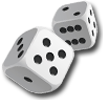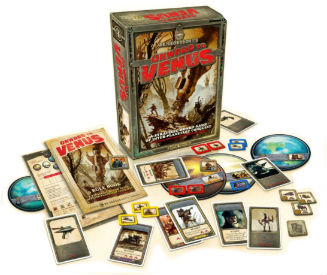



play board games
Board game reviews, strategy tips & session reports
Onward to Venus Board Game Review
 Stats:
Stats:
No. of players: 2-5
Amount of time to play: 90-120 min
Age requirements: 13+
Set-up time: 5 min
Onward to Venus is an interesting area control board game. You must race around the solar system building factories and mines on planets to score VPs.
Onward to Venus Rules Description:
Onward to Venus takes place on eight planets and moons (which I’ll refer to as planets from here on out) from our solar system. The planets are placed in a row starting with Mercury and ending at the Kuiper Belt. The moon and Earth are in their own column between Venus and Mars.
The game ends after three periods and each periods end once all the pass cubes have been taken. After placing a certain number of pass cubes (dependent on the number of players) on the pass card, you place tiles on each planet. The number of tiles depends on the planet and the number players.
You start the game with two spaceships and four infantry units orbiting Earth. On your turn you can move, claim a tile on a planet, buy more military units, play a card that uses your action or pass.
Only spaceships can move. They can move up to two planets and take any infantry from where they started with them. They cannot pick up and drop off infantry as they move and tanks cannot be moved unless you have a card that lets you move them. Some cards can boost your movement, and any time you don’t move your full movement you may still claim a tile.
There are eight types of tiles in the game. Four are defended and four are not. If you want to claim an undefended tile you simply land a unit on the planet and take that tile. The undefended tiles get you money, cards, a factory or big game. Factories get you income between rounds and help you work toward the win condition. Big game tiles are held until the end of the game and are worth 1 VP each.
The four defended tiles are mines, crisis tiles, tension tiles and aliens. These all have a defense value from one to seven. When you go to claim them you roll three six-sided dice. You remove the middle value from the results and subtract the other two. Then you add the tile’s defense value and you must meet that value in Combat Points. Infantry and spaceships provide one Combat Point and tanks provide two. You can also play cards that are worth Combat Points. So if you want to claim a mine with a defense of 3 and you rolled a 6, 5 and 2, you’d drop the 5. 6 minus 2 leaves 4 that is added to the mine’s 3 defense for a total of 6. You would have to commit units or play cards equal to six or more to claim the mine. Committed infantry and tank units land on the planet. Also instead of a 1 the dice have a skull. This counts as a zero and causes you to lose a committed unit after claiming the tile. Aliens and crisis tiles are worth VPs at the end of the game. Alien tiles only come out as the result of a level 4 crisis on Kuiper Belt (more on that below).
Tension tiles are a bit different. They let you take other players’ mines and factories. You roll like normal but that mine or factory’s defense is equal the owning player’s Combat Points for their units on or in orbit of that planet.
When you want more units you may buy one or two on your turn. Spaceships cost 4 and tanks cost 3. These units may be built anywhere you have a factory or Earth. Infantry cost two but must be built on Earth. New units are placed in orbit of the appropriate planet.
Cards let you re-roll dice, get extra Combat Points, gain money, or move farther than normal. Some are free actions but others use your action for the turn.
If you pass you take one card and remove one cube from the pass card. Once all cubes are removed the period is over. The player that took the last cube is the first player in the following period.
After the actions phase is over you resolve crisis tiles. Each crisis tile adds one crisis level to the planet it is on. If any crisis tile has a skull on it you roll the three dice. For each skull you roll you add that die to the planet with the crisis tile with the skull. If more than one crisis tile has a skull you start at Mercury and move out toward the Kuiper Belt placing one skull result on the appropriate planet. Then starting at Mercury you check the total Crisis Level on each planet. Depending on the planet different things will happen. Most of them can be ignored at level one, are bad at level three and game altering at level four. In fact if Earth ever reaches level four the game ends and everyone loses.
Next you gain income based on the mines and factories you have and return any units on a planet to that planet’s orbit.
Once three periods are over you score VPs based on you income on each planet. The play with the most income scores the most VPs, and so and so forth. You score first, second and in some cases third place and tied players all score the full number of VPs based on their rank. Then you add any points for Big Game, alien or crisis tiles you collected. The player with the most VPs wins.
Quick Review of Onward to Venus:
Onward to Venus is a medium weight game that is pretty simple to teach and learn. I am not familiar with the game’s source material but it has a steampunk theme.
The components for this game are excellent. The art is fantastic and the chits look great and are durable. The rules are pretty well written and easy to follow. The box could have a better insert but that is just a minor inconvenience.
I like the blending of randomness and strategy in this game. Some may think it is too random but I enjoy it. The dice can be swingy and getting good cards can help you get ahead. But you need to think about where you are going and what tiles to claim when. This is especially true of defended tiles. Having to land committed units almost give this game a worker placement feel. Once on a planet a unit will not act again until the next period.
Downtime in this game is fairly minimal. Since there are just five actions you can take turns don’t take long. Even with five it didn’t feel like things dragged.
I didn’t mention this above, but each player takes on the role of a nation. You get a starting set of four cards based on your nation and each nation has different cards. While this doesn’t alter play too much it is nice that each nation is different at the start.
The game is not perfect though. Like I said above the randomness might annoy some players. The randomness of the dice and cards is one thing. But when it comes to tile placement it can really mess you up. There is a chance that a planet you are close to winning first place for doesn’t get a mine or tension tile in the third period. There really is not much you can do to gain ground on your opponent there.
Also the crisis tiles are merely annoying. We never felt threatened by them. And if we did they were pretty easy to overcome. Their effects are really cool but I am nt sure how often they’ll trigger.
Lastly the two-player game was not nearly as good as games with three to five.
If you are looking for a fun, medium-weight, area control game, check out Onward to Venus. It plays fast, is easy to teach. It plays well with three to five players and can fill that niche in your collection.
Score and synopsis: (Click here for an explanation of these review categories.)
Strategy 3 out of 6
Luck 5 out of 6
Player Interaction 4 out of 6
Replay Value 5 out of 6
Complexity 4 out of 6
Fun 4 out of 6
Overall 4 out of 6

Leave a Reply